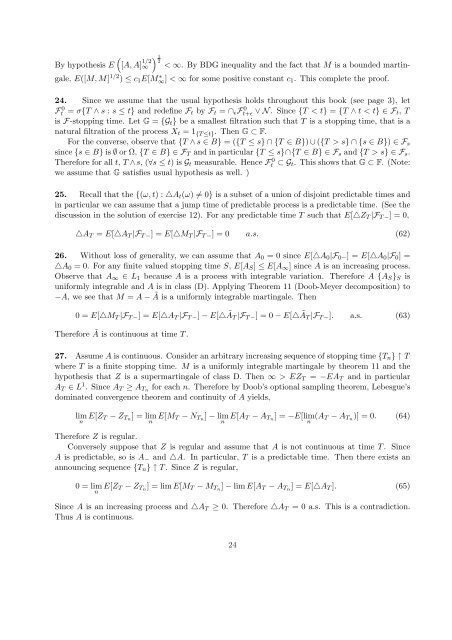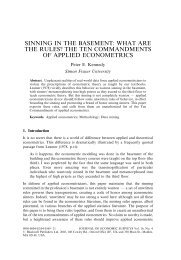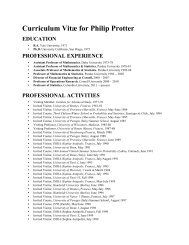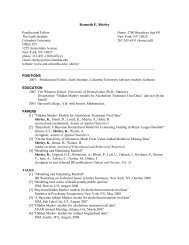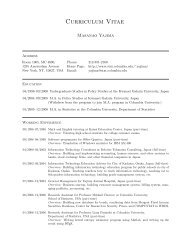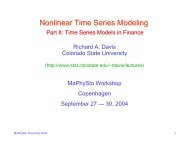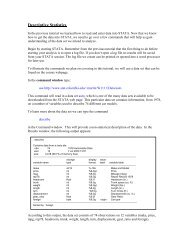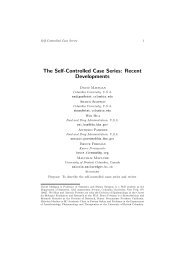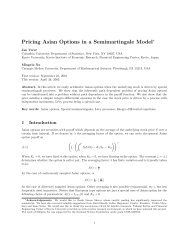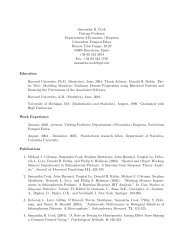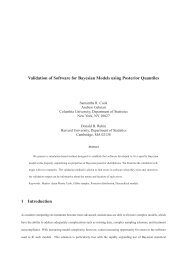Solution to selected problems.
Solution to selected problems.
Solution to selected problems.
You also want an ePaper? Increase the reach of your titles
YUMPU automatically turns print PDFs into web optimized ePapers that Google loves.
(<br />
By hypothesis E [A, A] 1/2<br />
∞<br />
) 1<br />
2<br />
< ∞. By BDG inequality and the fact that M is a bounded martingale,<br />
E([M, M] 1/2 ) ≤ c 1 E[M ∗ ∞] < ∞ for some positive constant c 1 . This complete the proof.<br />
24. Since we assume that the usual hypothesis holds throughout this book (see page 3), let<br />
Ft<br />
0 = σ{T ∧ s : s ≤ t} and redefine F t by F t = ∩ ɛ Ft+ɛ 0 ∨ N . Since {T < t} = {T ∧ t < t} ∈ F t , T<br />
is F-s<strong>to</strong>pping time. Let G = {G t } be a smallest filtration such that T is a s<strong>to</strong>pping time, that is a<br />
natural filtration of the process X t = 1 {T ≤t} . Then G ⊂ F.<br />
For the converse, observe that {T ∧ s ∈ B} = ({T ≤ s} ∩ {T ∈ B}) ∪ ({T > s} ∩ {s ∈ B}) ∈ F s<br />
since {s ∈ B} is ∅ or Ω, {T ∈ B} ∈ F T and in particular {T ≤ s}∩{T ∈ B} ∈ F s and {T > s} ∈ F s .<br />
Therefore for all t, T ∧s, (∀s ≤ t) is G t measurable. Hence Ft 0 ⊂ G t . This shows that G ⊂ F. (Note:<br />
we assume that G satisfies usual hypothesis as well. )<br />
25. Recall that the {(ω, t) : △A t (ω) ≠ 0} is a subset of a union of disjoint predictable times and<br />
in particular we can assume that a jump time of predictable process is a predictable time. (See the<br />
discussion in the solution of exercise 12). For any predictable time T such that E[△Z T |F T − ] = 0,<br />
△A T = E[△A T |F T − ] = E[△M T |F T − ] = 0 a.s. (62)<br />
26. Without loss of generality, we can assume that A 0 = 0 since E[△A 0 |F 0− ] = E[△A 0 |F 0 ] =<br />
△A 0 = 0. For any finite valued s<strong>to</strong>pping time S, E[A S ] ≤ E[A ∞ ] since A is an increasing process.<br />
Observe that A ∞ ∈ L 1 because A is a process with integrable variation. Therefore A {A S } S is<br />
uniformly integrable and A is in class (D). Applying Theorem 11 (Doob-Meyer decomposition) <strong>to</strong><br />
−A, we see that M = A − Ã is a uniformly integrable martingale. Then<br />
0 = E[△M T |F T − ] = E[△A T |F T − ] − E[△ÃT |F T − ] = 0 − E[△ÃT |F T − ]. a.s. (63)<br />
Therefore à is continuous at time T .<br />
27. Assume A is continuous. Consider an arbitrary increasing sequence of s<strong>to</strong>pping time {T n } ↑ T<br />
where T is a finite s<strong>to</strong>pping time. M is a uniformly integrable martingale by theorem 11 and the<br />
hypothesis that Z is a supermartingale of class D. Then ∞ > EZ T = −EA T and in particular<br />
A T ∈ L 1 . Since A T ≥ A Tn for each n. Therefore by Doob’s optional sampling theorem, Lebesgue’s<br />
dominated convergence theorem and continuity of A yields,<br />
lim<br />
n<br />
E[Z T − Z Tn ] = lim<br />
n<br />
E[M T − N Tn ] − lim<br />
n<br />
E[A T − A Tn ] = −E[lim<br />
n<br />
(A T − A Tn )] = 0. (64)<br />
Therefore Z is regular.<br />
Conversely suppose that Z is regular and assume that A is not continuous at time T . Since<br />
A is predictable, so is A − and △A. In particular, T is a predictable time. Then there exists an<br />
announcing sequence {T n } ↑ T . Since Z is regular,<br />
0 = lim<br />
n<br />
E[Z T − Z Tn ] = lim E[M T − M Tn ] − lim E[A T − A Tn ] = E[△A T ]. (65)<br />
Since A is an increasing process and △A T ≥ 0. Therefore △A T = 0 a.s. This is a contradiction.<br />
Thus A is continuous.<br />
24


